(Doc) Training and Development Assignment
VerifiedAdded on 2021/05/31
|17
|4401
|17
AI Summary
Contribute Materials
Your contribution can guide someone’s learning journey. Share your
documents today.
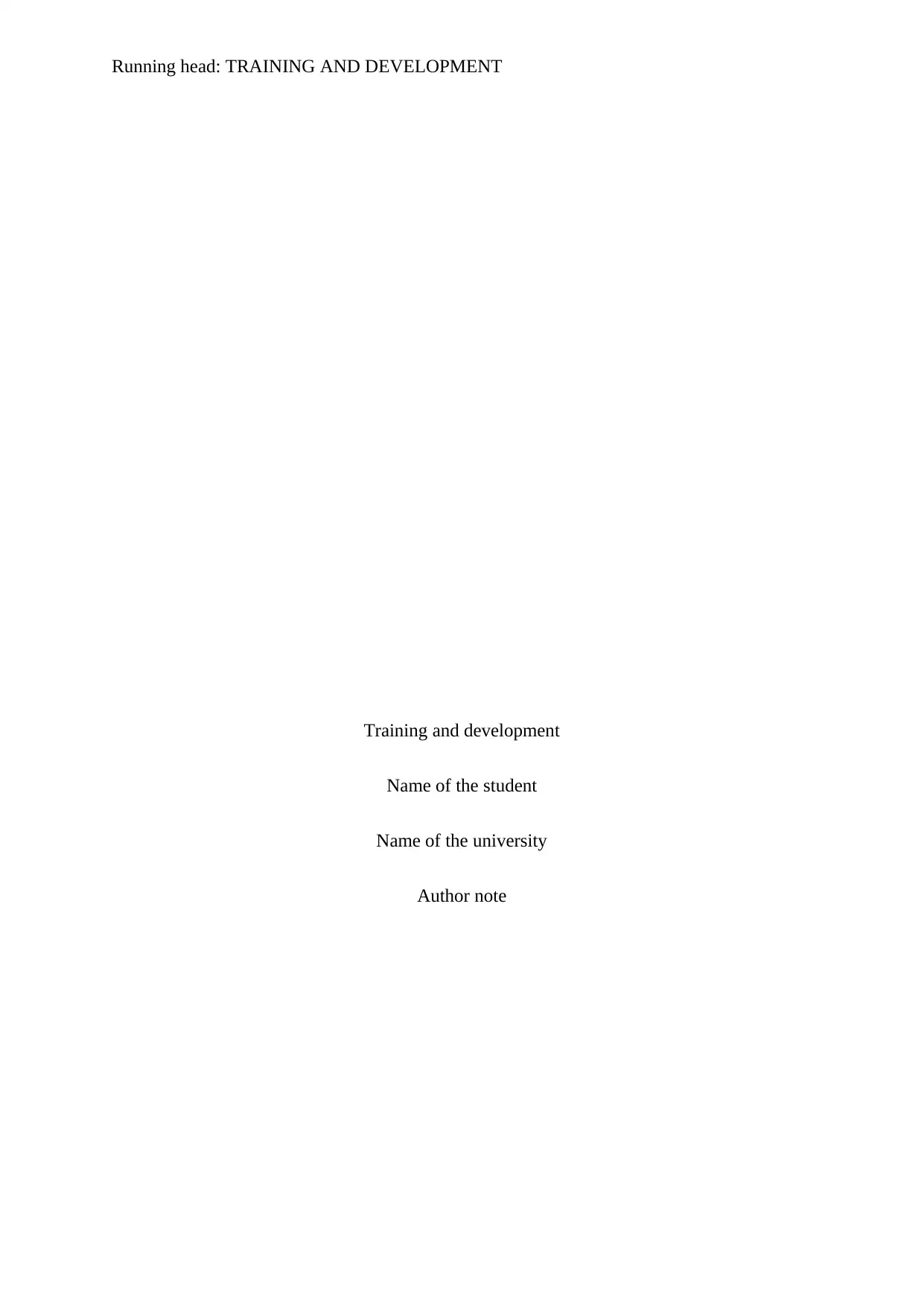
Running head: TRAINING AND DEVELOPMENT
Training and development
Name of the student
Name of the university
Author note
Training and development
Name of the student
Name of the university
Author note
Secure Best Marks with AI Grader
Need help grading? Try our AI Grader for instant feedback on your assignments.
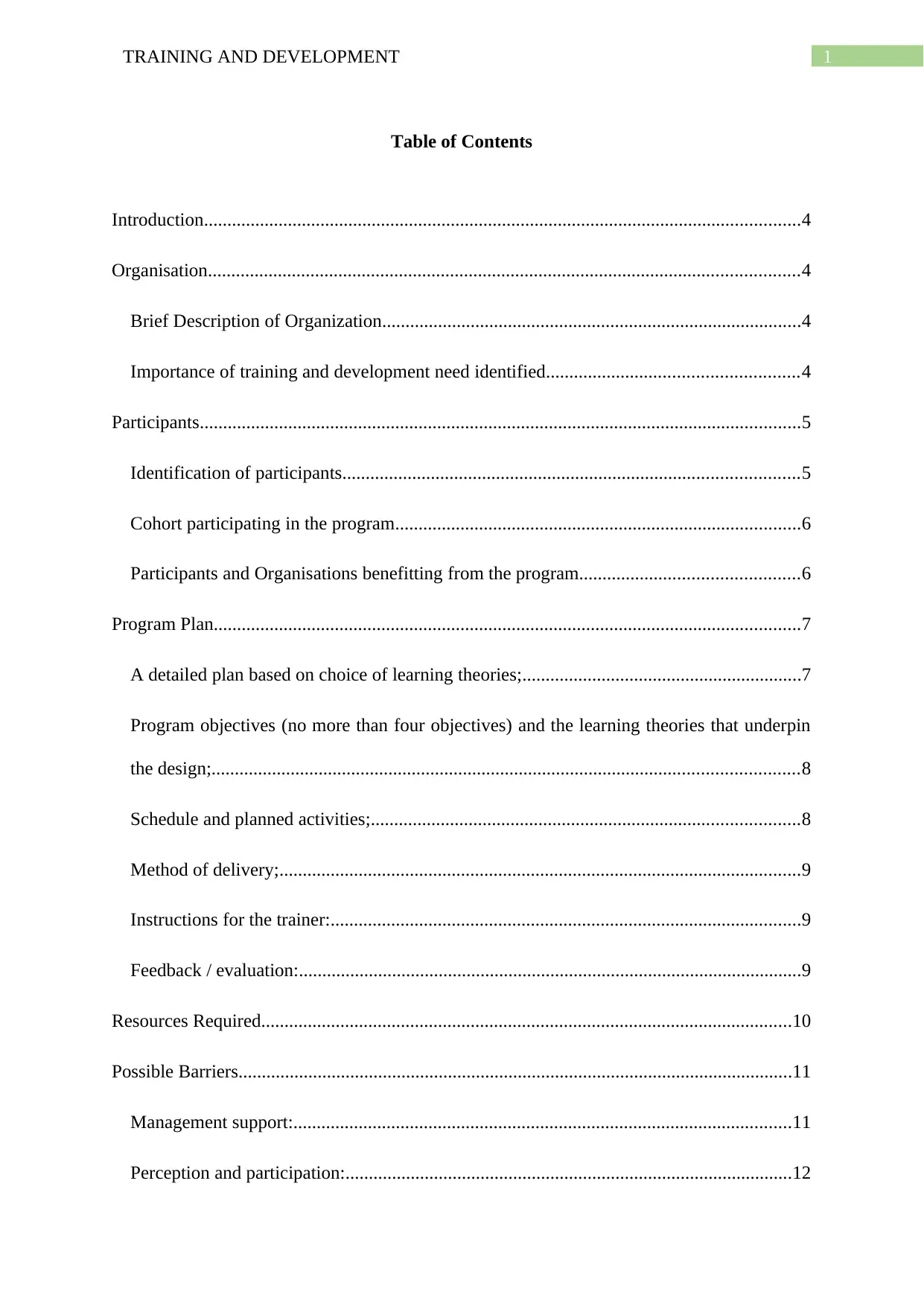
1TRAINING AND DEVELOPMENT
Table of Contents
Introduction................................................................................................................................4
Organisation...............................................................................................................................4
Brief Description of Organization..........................................................................................4
Importance of training and development need identified......................................................4
Participants.................................................................................................................................5
Identification of participants..................................................................................................5
Cohort participating in the program.......................................................................................6
Participants and Organisations benefitting from the program...............................................6
Program Plan..............................................................................................................................7
A detailed plan based on choice of learning theories;............................................................7
Program objectives (no more than four objectives) and the learning theories that underpin
the design;..............................................................................................................................8
Schedule and planned activities;............................................................................................8
Method of delivery;................................................................................................................9
Instructions for the trainer:.....................................................................................................9
Feedback / evaluation:............................................................................................................9
Resources Required..................................................................................................................10
Possible Barriers.......................................................................................................................11
Management support:...........................................................................................................11
Perception and participation:................................................................................................12
Table of Contents
Introduction................................................................................................................................4
Organisation...............................................................................................................................4
Brief Description of Organization..........................................................................................4
Importance of training and development need identified......................................................4
Participants.................................................................................................................................5
Identification of participants..................................................................................................5
Cohort participating in the program.......................................................................................6
Participants and Organisations benefitting from the program...............................................6
Program Plan..............................................................................................................................7
A detailed plan based on choice of learning theories;............................................................7
Program objectives (no more than four objectives) and the learning theories that underpin
the design;..............................................................................................................................8
Schedule and planned activities;............................................................................................8
Method of delivery;................................................................................................................9
Instructions for the trainer:.....................................................................................................9
Feedback / evaluation:............................................................................................................9
Resources Required..................................................................................................................10
Possible Barriers.......................................................................................................................11
Management support:...........................................................................................................11
Perception and participation:................................................................................................12

2TRAINING AND DEVELOPMENT
Finance;................................................................................................................................12
Conflicting priorities:...........................................................................................................12
Conclusion................................................................................................................................13
References................................................................................................................................14
Finance;................................................................................................................................12
Conflicting priorities:...........................................................................................................12
Conclusion................................................................................................................................13
References................................................................................................................................14

3TRAINING AND DEVELOPMENT
Introduction
Training has become a necessary requirement in all the organizations in the
contemporary world. In the earlier times training was not considered to be an important part.
The organization practiced a traditional form of doing business. In the contemporary world
all the industries follow a strict process of training. They believe in the grooming of the body
language of the employees which is possible only through a systematic training.
Organisation
Brief Description of Organization
Medtronic Company of Australia is a pioneer in the field of medical technology along
with services. It helps in saving the lives of the people by providing health care facility that is
of supreme quality. The innovations of Medtronic Company have been able to change the
lives of 65 million people and therapy management helps in removing the pain of the
patients. The different therapies along with procedures helps in relieving the critical condition
of the patients. Medtronic Australia is making use of clinical along with therapeutic expertise
that can help in providing great service for the patients (Johnson & Gandhi, 2015). Medtronic
Australia has collaborated with different stakeholders so that it can help in taking the process
of healthcare further. It has helped in transforming the healthcare system and enabled the re-
thinking of the status quo. The sector of healthcare is facing great challenges and technology
has greatly helped Medtronic Australia in aligning value to the providers along with the
stakeholders. The mission of the company revolves around alleviation of pain along with
restoring of health.
Importance of training and development need identified
The performance gaps of Medtronic Australia being identified can help in conducting
the training program that can help in improving the quality of service pertaining to Medtronic
Introduction
Training has become a necessary requirement in all the organizations in the
contemporary world. In the earlier times training was not considered to be an important part.
The organization practiced a traditional form of doing business. In the contemporary world
all the industries follow a strict process of training. They believe in the grooming of the body
language of the employees which is possible only through a systematic training.
Organisation
Brief Description of Organization
Medtronic Company of Australia is a pioneer in the field of medical technology along
with services. It helps in saving the lives of the people by providing health care facility that is
of supreme quality. The innovations of Medtronic Company have been able to change the
lives of 65 million people and therapy management helps in removing the pain of the
patients. The different therapies along with procedures helps in relieving the critical condition
of the patients. Medtronic Australia is making use of clinical along with therapeutic expertise
that can help in providing great service for the patients (Johnson & Gandhi, 2015). Medtronic
Australia has collaborated with different stakeholders so that it can help in taking the process
of healthcare further. It has helped in transforming the healthcare system and enabled the re-
thinking of the status quo. The sector of healthcare is facing great challenges and technology
has greatly helped Medtronic Australia in aligning value to the providers along with the
stakeholders. The mission of the company revolves around alleviation of pain along with
restoring of health.
Importance of training and development need identified
The performance gaps of Medtronic Australia being identified can help in conducting
the training program that can help in improving the quality of service pertaining to Medtronic
Secure Best Marks with AI Grader
Need help grading? Try our AI Grader for instant feedback on your assignments.
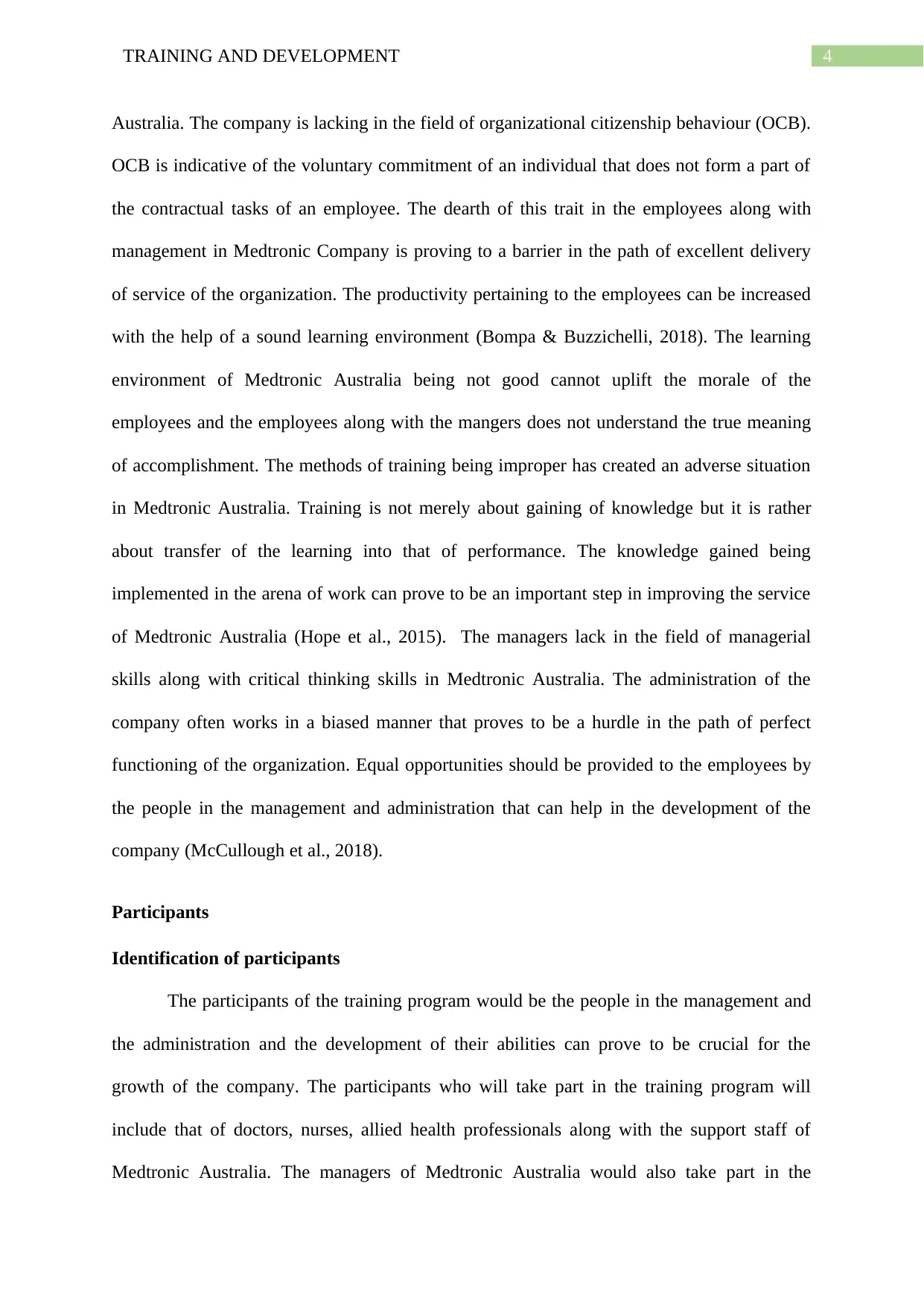
4TRAINING AND DEVELOPMENT
Australia. The company is lacking in the field of organizational citizenship behaviour (OCB).
OCB is indicative of the voluntary commitment of an individual that does not form a part of
the contractual tasks of an employee. The dearth of this trait in the employees along with
management in Medtronic Company is proving to a barrier in the path of excellent delivery
of service of the organization. The productivity pertaining to the employees can be increased
with the help of a sound learning environment (Bompa & Buzzichelli, 2018). The learning
environment of Medtronic Australia being not good cannot uplift the morale of the
employees and the employees along with the mangers does not understand the true meaning
of accomplishment. The methods of training being improper has created an adverse situation
in Medtronic Australia. Training is not merely about gaining of knowledge but it is rather
about transfer of the learning into that of performance. The knowledge gained being
implemented in the arena of work can prove to be an important step in improving the service
of Medtronic Australia (Hope et al., 2015). The managers lack in the field of managerial
skills along with critical thinking skills in Medtronic Australia. The administration of the
company often works in a biased manner that proves to be a hurdle in the path of perfect
functioning of the organization. Equal opportunities should be provided to the employees by
the people in the management and administration that can help in the development of the
company (McCullough et al., 2018).
Participants
Identification of participants
The participants of the training program would be the people in the management and
the administration and the development of their abilities can prove to be crucial for the
growth of the company. The participants who will take part in the training program will
include that of doctors, nurses, allied health professionals along with the support staff of
Medtronic Australia. The managers of Medtronic Australia would also take part in the
Australia. The company is lacking in the field of organizational citizenship behaviour (OCB).
OCB is indicative of the voluntary commitment of an individual that does not form a part of
the contractual tasks of an employee. The dearth of this trait in the employees along with
management in Medtronic Company is proving to a barrier in the path of excellent delivery
of service of the organization. The productivity pertaining to the employees can be increased
with the help of a sound learning environment (Bompa & Buzzichelli, 2018). The learning
environment of Medtronic Australia being not good cannot uplift the morale of the
employees and the employees along with the mangers does not understand the true meaning
of accomplishment. The methods of training being improper has created an adverse situation
in Medtronic Australia. Training is not merely about gaining of knowledge but it is rather
about transfer of the learning into that of performance. The knowledge gained being
implemented in the arena of work can prove to be an important step in improving the service
of Medtronic Australia (Hope et al., 2015). The managers lack in the field of managerial
skills along with critical thinking skills in Medtronic Australia. The administration of the
company often works in a biased manner that proves to be a hurdle in the path of perfect
functioning of the organization. Equal opportunities should be provided to the employees by
the people in the management and administration that can help in the development of the
company (McCullough et al., 2018).
Participants
Identification of participants
The participants of the training program would be the people in the management and
the administration and the development of their abilities can prove to be crucial for the
growth of the company. The participants who will take part in the training program will
include that of doctors, nurses, allied health professionals along with the support staff of
Medtronic Australia. The managers of Medtronic Australia would also take part in the

5TRAINING AND DEVELOPMENT
training that can help in improving the quality of service that is delivered by the hospital
(Henoch et al., 2015). The doctors cannot provide training in the appropriate manner and
practical means should be adopted that can help the health care professionals in providing
effective service in the company.
Cohort participating in the program
Institutional cohorts can help in providing health care facilities on the site and this can
be taken recourse to by Medtronic Australia for improving the quality of work of the people
involved in the health care service. The cohort participating in the training program includes
the health professionals and the support staff. Training can help in improving the quality of
health care that is provided by the support staff of Medtronic Australia. The arenas that
should be stressed during the training program are in the field of communication that can help
in removal of many barriers arising in Medtronic Australia. A revolution is taking place in the
field of technology and Medical Technology Association of Australia can be taken help of in
order to enlighten the employees in Medtronic Australia about the innovations that has taken
place in the field of health care (Fujimori et al., 2014). It can help in developing a
knowledgeable along with sustainable technology-driven workforce. It can help in the
process of professional development of the employees and it can help in covering important
aspects of innovation and systemic thinking.
Participants and Organisations benefitting from the program
The participants will be able to learn about the recent interventions along with
technologies that will greatly benefit Medtronic Australia. The training programs will help
the managers in understanding the needs of the patients and how they should respond in
relation to different kinds of situations. These programs can help in retaining the current
employees and improving their skills that can help in the developing of Medtronic Australia.
It can have a positive impact on the quality of health care system in Medtronic Australia. The
training that can help in improving the quality of service that is delivered by the hospital
(Henoch et al., 2015). The doctors cannot provide training in the appropriate manner and
practical means should be adopted that can help the health care professionals in providing
effective service in the company.
Cohort participating in the program
Institutional cohorts can help in providing health care facilities on the site and this can
be taken recourse to by Medtronic Australia for improving the quality of work of the people
involved in the health care service. The cohort participating in the training program includes
the health professionals and the support staff. Training can help in improving the quality of
health care that is provided by the support staff of Medtronic Australia. The arenas that
should be stressed during the training program are in the field of communication that can help
in removal of many barriers arising in Medtronic Australia. A revolution is taking place in the
field of technology and Medical Technology Association of Australia can be taken help of in
order to enlighten the employees in Medtronic Australia about the innovations that has taken
place in the field of health care (Fujimori et al., 2014). It can help in developing a
knowledgeable along with sustainable technology-driven workforce. It can help in the
process of professional development of the employees and it can help in covering important
aspects of innovation and systemic thinking.
Participants and Organisations benefitting from the program
The participants will be able to learn about the recent interventions along with
technologies that will greatly benefit Medtronic Australia. The training programs will help
the managers in understanding the needs of the patients and how they should respond in
relation to different kinds of situations. These programs can help in retaining the current
employees and improving their skills that can help in the developing of Medtronic Australia.
It can have a positive impact on the quality of health care system in Medtronic Australia. The
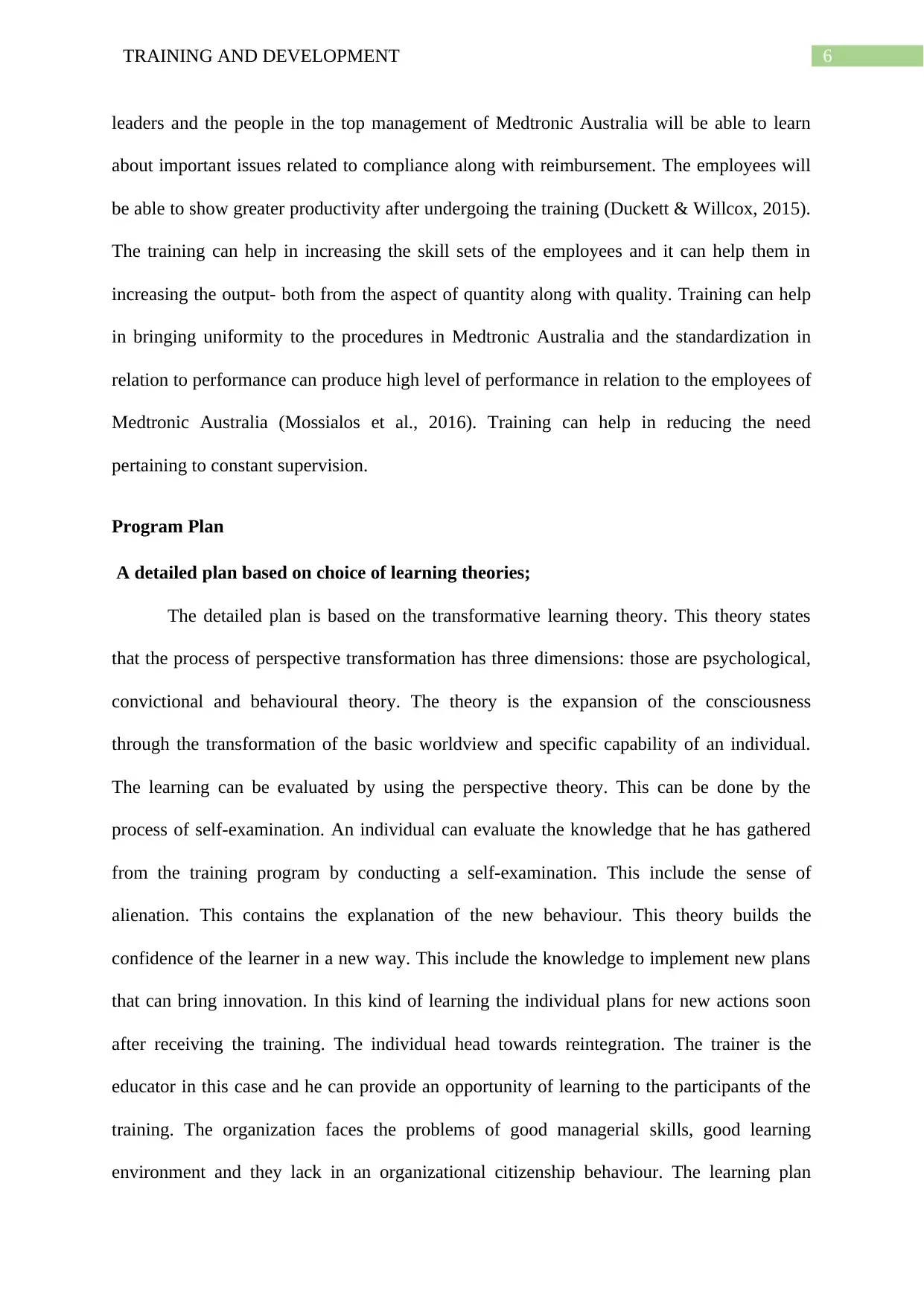
6TRAINING AND DEVELOPMENT
leaders and the people in the top management of Medtronic Australia will be able to learn
about important issues related to compliance along with reimbursement. The employees will
be able to show greater productivity after undergoing the training (Duckett & Willcox, 2015).
The training can help in increasing the skill sets of the employees and it can help them in
increasing the output- both from the aspect of quantity along with quality. Training can help
in bringing uniformity to the procedures in Medtronic Australia and the standardization in
relation to performance can produce high level of performance in relation to the employees of
Medtronic Australia (Mossialos et al., 2016). Training can help in reducing the need
pertaining to constant supervision.
Program Plan
A detailed plan based on choice of learning theories;
The detailed plan is based on the transformative learning theory. This theory states
that the process of perspective transformation has three dimensions: those are psychological,
convictional and behavioural theory. The theory is the expansion of the consciousness
through the transformation of the basic worldview and specific capability of an individual.
The learning can be evaluated by using the perspective theory. This can be done by the
process of self-examination. An individual can evaluate the knowledge that he has gathered
from the training program by conducting a self-examination. This include the sense of
alienation. This contains the explanation of the new behaviour. This theory builds the
confidence of the learner in a new way. This include the knowledge to implement new plans
that can bring innovation. In this kind of learning the individual plans for new actions soon
after receiving the training. The individual head towards reintegration. The trainer is the
educator in this case and he can provide an opportunity of learning to the participants of the
training. The organization faces the problems of good managerial skills, good learning
environment and they lack in an organizational citizenship behaviour. The learning plan
leaders and the people in the top management of Medtronic Australia will be able to learn
about important issues related to compliance along with reimbursement. The employees will
be able to show greater productivity after undergoing the training (Duckett & Willcox, 2015).
The training can help in increasing the skill sets of the employees and it can help them in
increasing the output- both from the aspect of quantity along with quality. Training can help
in bringing uniformity to the procedures in Medtronic Australia and the standardization in
relation to performance can produce high level of performance in relation to the employees of
Medtronic Australia (Mossialos et al., 2016). Training can help in reducing the need
pertaining to constant supervision.
Program Plan
A detailed plan based on choice of learning theories;
The detailed plan is based on the transformative learning theory. This theory states
that the process of perspective transformation has three dimensions: those are psychological,
convictional and behavioural theory. The theory is the expansion of the consciousness
through the transformation of the basic worldview and specific capability of an individual.
The learning can be evaluated by using the perspective theory. This can be done by the
process of self-examination. An individual can evaluate the knowledge that he has gathered
from the training program by conducting a self-examination. This include the sense of
alienation. This contains the explanation of the new behaviour. This theory builds the
confidence of the learner in a new way. This include the knowledge to implement new plans
that can bring innovation. In this kind of learning the individual plans for new actions soon
after receiving the training. The individual head towards reintegration. The trainer is the
educator in this case and he can provide an opportunity of learning to the participants of the
training. The organization faces the problems of good managerial skills, good learning
environment and they lack in an organizational citizenship behaviour. The learning plan
Paraphrase This Document
Need a fresh take? Get an instant paraphrase of this document with our AI Paraphraser
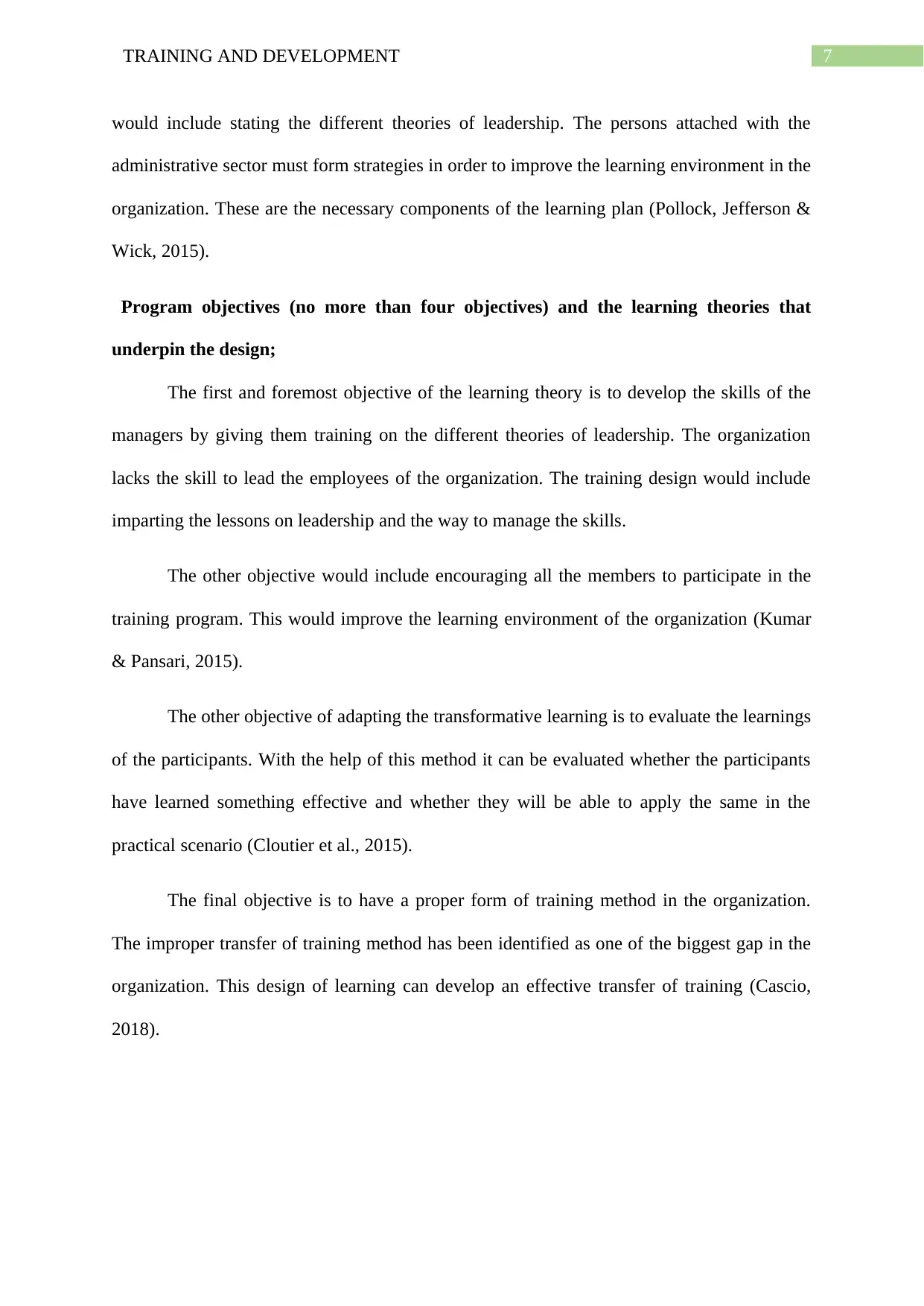
7TRAINING AND DEVELOPMENT
would include stating the different theories of leadership. The persons attached with the
administrative sector must form strategies in order to improve the learning environment in the
organization. These are the necessary components of the learning plan (Pollock, Jefferson &
Wick, 2015).
Program objectives (no more than four objectives) and the learning theories that
underpin the design;
The first and foremost objective of the learning theory is to develop the skills of the
managers by giving them training on the different theories of leadership. The organization
lacks the skill to lead the employees of the organization. The training design would include
imparting the lessons on leadership and the way to manage the skills.
The other objective would include encouraging all the members to participate in the
training program. This would improve the learning environment of the organization (Kumar
& Pansari, 2015).
The other objective of adapting the transformative learning is to evaluate the learnings
of the participants. With the help of this method it can be evaluated whether the participants
have learned something effective and whether they will be able to apply the same in the
practical scenario (Cloutier et al., 2015).
The final objective is to have a proper form of training method in the organization.
The improper transfer of training method has been identified as one of the biggest gap in the
organization. This design of learning can develop an effective transfer of training (Cascio,
2018).
would include stating the different theories of leadership. The persons attached with the
administrative sector must form strategies in order to improve the learning environment in the
organization. These are the necessary components of the learning plan (Pollock, Jefferson &
Wick, 2015).
Program objectives (no more than four objectives) and the learning theories that
underpin the design;
The first and foremost objective of the learning theory is to develop the skills of the
managers by giving them training on the different theories of leadership. The organization
lacks the skill to lead the employees of the organization. The training design would include
imparting the lessons on leadership and the way to manage the skills.
The other objective would include encouraging all the members to participate in the
training program. This would improve the learning environment of the organization (Kumar
& Pansari, 2015).
The other objective of adapting the transformative learning is to evaluate the learnings
of the participants. With the help of this method it can be evaluated whether the participants
have learned something effective and whether they will be able to apply the same in the
practical scenario (Cloutier et al., 2015).
The final objective is to have a proper form of training method in the organization.
The improper transfer of training method has been identified as one of the biggest gap in the
organization. This design of learning can develop an effective transfer of training (Cascio,
2018).
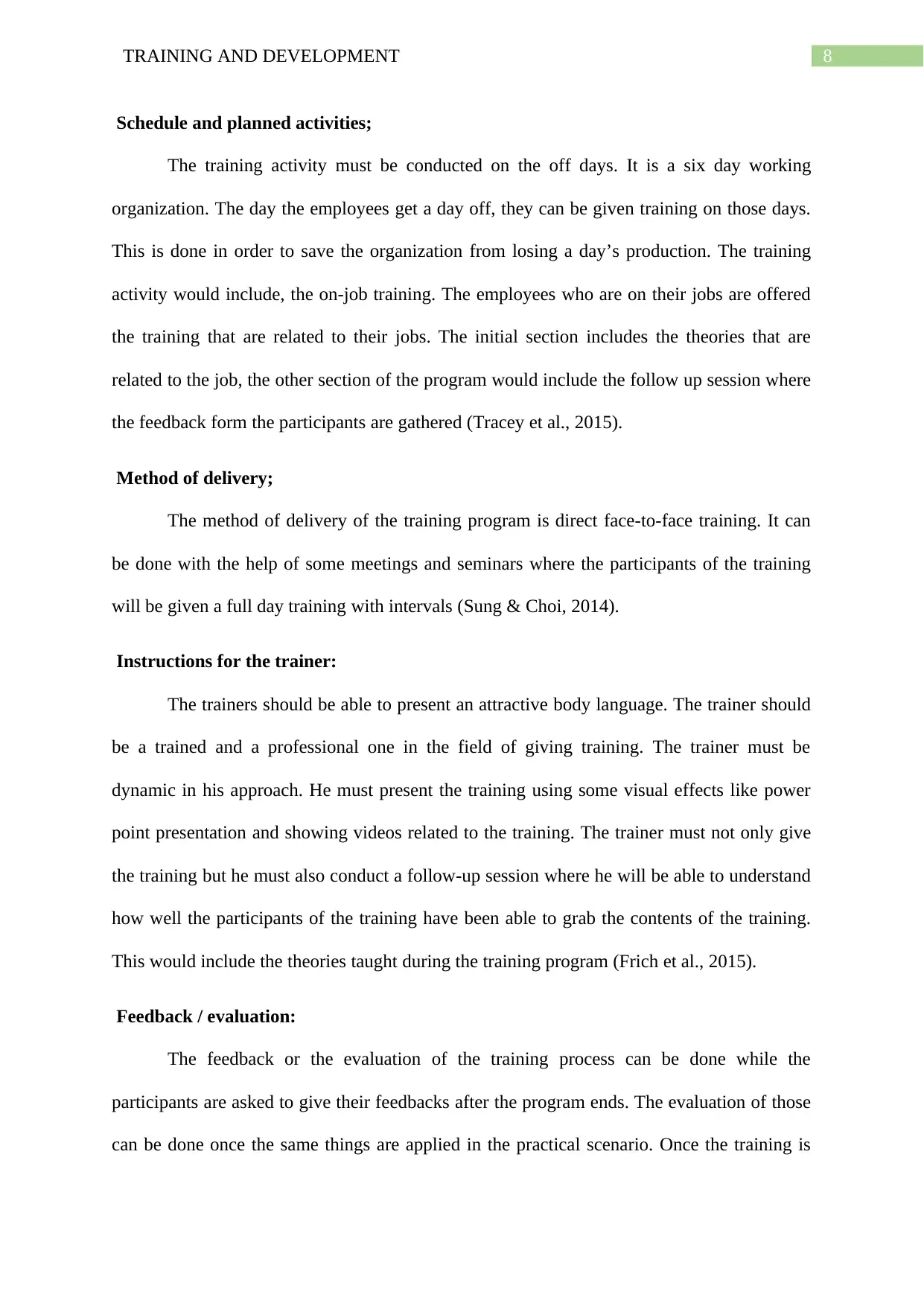
8TRAINING AND DEVELOPMENT
Schedule and planned activities;
The training activity must be conducted on the off days. It is a six day working
organization. The day the employees get a day off, they can be given training on those days.
This is done in order to save the organization from losing a day’s production. The training
activity would include, the on-job training. The employees who are on their jobs are offered
the training that are related to their jobs. The initial section includes the theories that are
related to the job, the other section of the program would include the follow up session where
the feedback form the participants are gathered (Tracey et al., 2015).
Method of delivery;
The method of delivery of the training program is direct face-to-face training. It can
be done with the help of some meetings and seminars where the participants of the training
will be given a full day training with intervals (Sung & Choi, 2014).
Instructions for the trainer:
The trainers should be able to present an attractive body language. The trainer should
be a trained and a professional one in the field of giving training. The trainer must be
dynamic in his approach. He must present the training using some visual effects like power
point presentation and showing videos related to the training. The trainer must not only give
the training but he must also conduct a follow-up session where he will be able to understand
how well the participants of the training have been able to grab the contents of the training.
This would include the theories taught during the training program (Frich et al., 2015).
Feedback / evaluation:
The feedback or the evaluation of the training process can be done while the
participants are asked to give their feedbacks after the program ends. The evaluation of those
can be done once the same things are applied in the practical scenario. Once the training is
Schedule and planned activities;
The training activity must be conducted on the off days. It is a six day working
organization. The day the employees get a day off, they can be given training on those days.
This is done in order to save the organization from losing a day’s production. The training
activity would include, the on-job training. The employees who are on their jobs are offered
the training that are related to their jobs. The initial section includes the theories that are
related to the job, the other section of the program would include the follow up session where
the feedback form the participants are gathered (Tracey et al., 2015).
Method of delivery;
The method of delivery of the training program is direct face-to-face training. It can
be done with the help of some meetings and seminars where the participants of the training
will be given a full day training with intervals (Sung & Choi, 2014).
Instructions for the trainer:
The trainers should be able to present an attractive body language. The trainer should
be a trained and a professional one in the field of giving training. The trainer must be
dynamic in his approach. He must present the training using some visual effects like power
point presentation and showing videos related to the training. The trainer must not only give
the training but he must also conduct a follow-up session where he will be able to understand
how well the participants of the training have been able to grab the contents of the training.
This would include the theories taught during the training program (Frich et al., 2015).
Feedback / evaluation:
The feedback or the evaluation of the training process can be done while the
participants are asked to give their feedbacks after the program ends. The evaluation of those
can be done once the same things are applied in the practical scenario. Once the training is
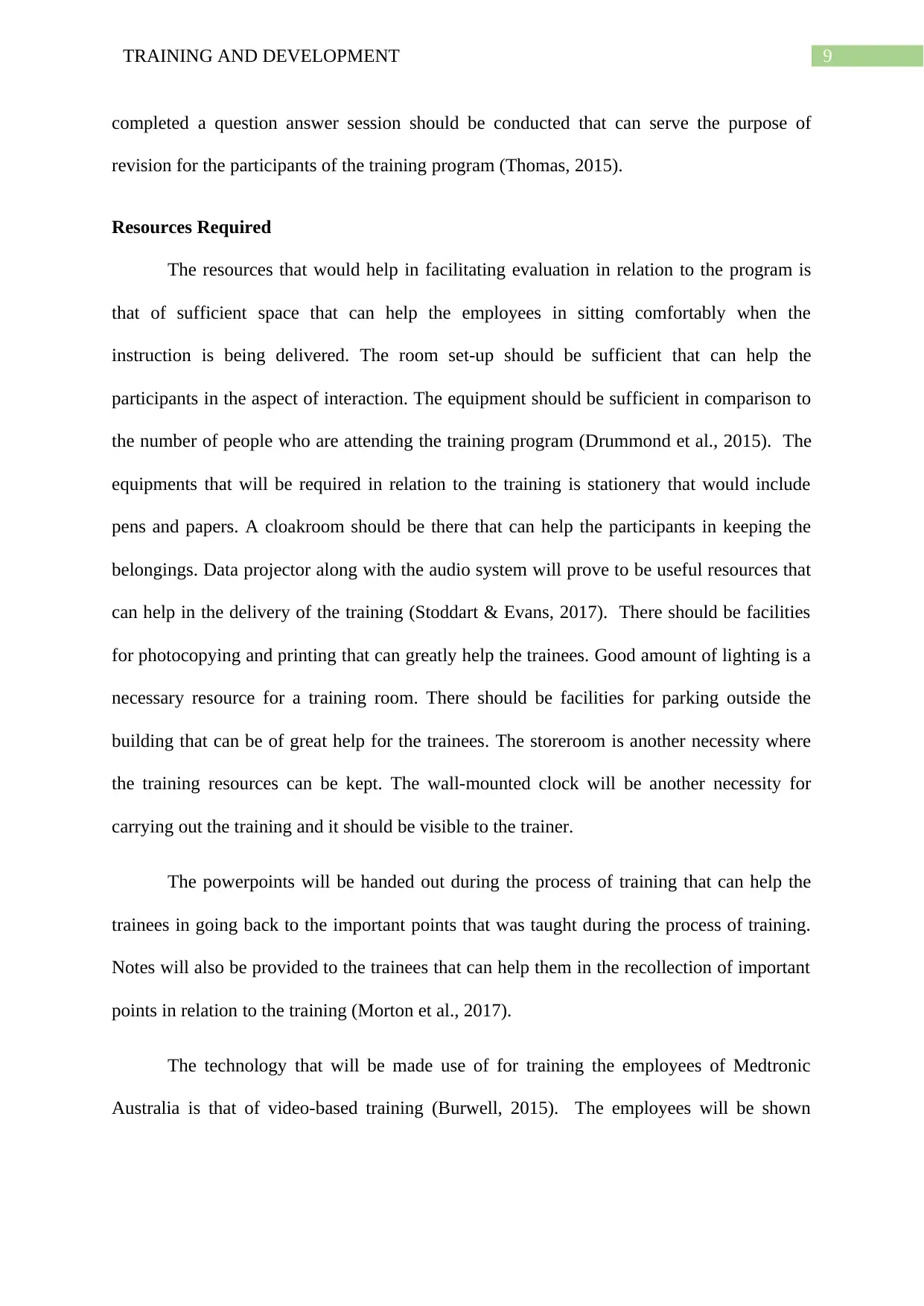
9TRAINING AND DEVELOPMENT
completed a question answer session should be conducted that can serve the purpose of
revision for the participants of the training program (Thomas, 2015).
Resources Required
The resources that would help in facilitating evaluation in relation to the program is
that of sufficient space that can help the employees in sitting comfortably when the
instruction is being delivered. The room set-up should be sufficient that can help the
participants in the aspect of interaction. The equipment should be sufficient in comparison to
the number of people who are attending the training program (Drummond et al., 2015). The
equipments that will be required in relation to the training is stationery that would include
pens and papers. A cloakroom should be there that can help the participants in keeping the
belongings. Data projector along with the audio system will prove to be useful resources that
can help in the delivery of the training (Stoddart & Evans, 2017). There should be facilities
for photocopying and printing that can greatly help the trainees. Good amount of lighting is a
necessary resource for a training room. There should be facilities for parking outside the
building that can be of great help for the trainees. The storeroom is another necessity where
the training resources can be kept. The wall-mounted clock will be another necessity for
carrying out the training and it should be visible to the trainer.
The powerpoints will be handed out during the process of training that can help the
trainees in going back to the important points that was taught during the process of training.
Notes will also be provided to the trainees that can help them in the recollection of important
points in relation to the training (Morton et al., 2017).
The technology that will be made use of for training the employees of Medtronic
Australia is that of video-based training (Burwell, 2015). The employees will be shown
completed a question answer session should be conducted that can serve the purpose of
revision for the participants of the training program (Thomas, 2015).
Resources Required
The resources that would help in facilitating evaluation in relation to the program is
that of sufficient space that can help the employees in sitting comfortably when the
instruction is being delivered. The room set-up should be sufficient that can help the
participants in the aspect of interaction. The equipment should be sufficient in comparison to
the number of people who are attending the training program (Drummond et al., 2015). The
equipments that will be required in relation to the training is stationery that would include
pens and papers. A cloakroom should be there that can help the participants in keeping the
belongings. Data projector along with the audio system will prove to be useful resources that
can help in the delivery of the training (Stoddart & Evans, 2017). There should be facilities
for photocopying and printing that can greatly help the trainees. Good amount of lighting is a
necessary resource for a training room. There should be facilities for parking outside the
building that can be of great help for the trainees. The storeroom is another necessity where
the training resources can be kept. The wall-mounted clock will be another necessity for
carrying out the training and it should be visible to the trainer.
The powerpoints will be handed out during the process of training that can help the
trainees in going back to the important points that was taught during the process of training.
Notes will also be provided to the trainees that can help them in the recollection of important
points in relation to the training (Morton et al., 2017).
The technology that will be made use of for training the employees of Medtronic
Australia is that of video-based training (Burwell, 2015). The employees will be shown
Secure Best Marks with AI Grader
Need help grading? Try our AI Grader for instant feedback on your assignments.
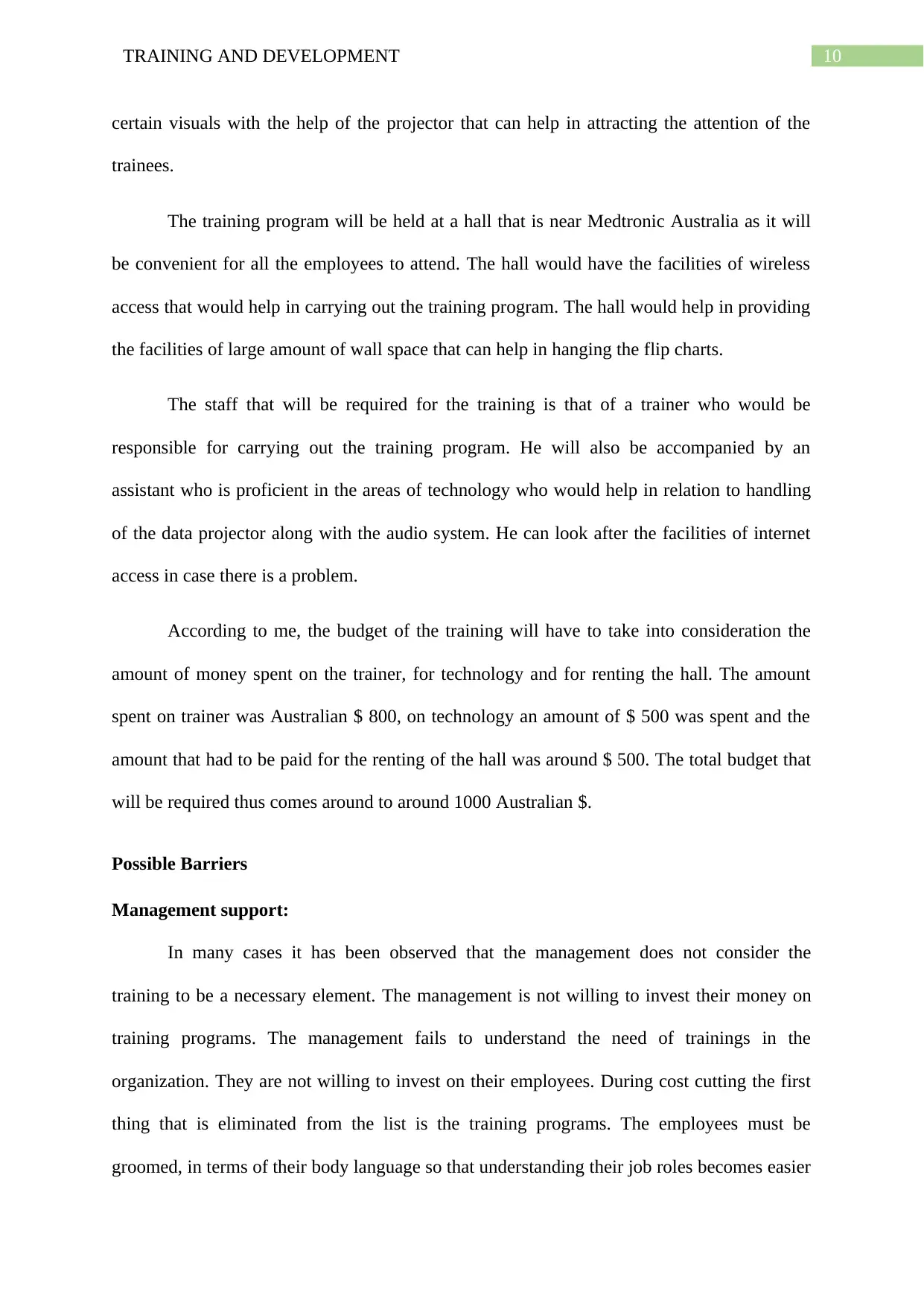
10TRAINING AND DEVELOPMENT
certain visuals with the help of the projector that can help in attracting the attention of the
trainees.
The training program will be held at a hall that is near Medtronic Australia as it will
be convenient for all the employees to attend. The hall would have the facilities of wireless
access that would help in carrying out the training program. The hall would help in providing
the facilities of large amount of wall space that can help in hanging the flip charts.
The staff that will be required for the training is that of a trainer who would be
responsible for carrying out the training program. He will also be accompanied by an
assistant who is proficient in the areas of technology who would help in relation to handling
of the data projector along with the audio system. He can look after the facilities of internet
access in case there is a problem.
According to me, the budget of the training will have to take into consideration the
amount of money spent on the trainer, for technology and for renting the hall. The amount
spent on trainer was Australian $ 800, on technology an amount of $ 500 was spent and the
amount that had to be paid for the renting of the hall was around $ 500. The total budget that
will be required thus comes around to around 1000 Australian $.
Possible Barriers
Management support:
In many cases it has been observed that the management does not consider the
training to be a necessary element. The management is not willing to invest their money on
training programs. The management fails to understand the need of trainings in the
organization. They are not willing to invest on their employees. During cost cutting the first
thing that is eliminated from the list is the training programs. The employees must be
groomed, in terms of their body language so that understanding their job roles becomes easier
certain visuals with the help of the projector that can help in attracting the attention of the
trainees.
The training program will be held at a hall that is near Medtronic Australia as it will
be convenient for all the employees to attend. The hall would have the facilities of wireless
access that would help in carrying out the training program. The hall would help in providing
the facilities of large amount of wall space that can help in hanging the flip charts.
The staff that will be required for the training is that of a trainer who would be
responsible for carrying out the training program. He will also be accompanied by an
assistant who is proficient in the areas of technology who would help in relation to handling
of the data projector along with the audio system. He can look after the facilities of internet
access in case there is a problem.
According to me, the budget of the training will have to take into consideration the
amount of money spent on the trainer, for technology and for renting the hall. The amount
spent on trainer was Australian $ 800, on technology an amount of $ 500 was spent and the
amount that had to be paid for the renting of the hall was around $ 500. The total budget that
will be required thus comes around to around 1000 Australian $.
Possible Barriers
Management support:
In many cases it has been observed that the management does not consider the
training to be a necessary element. The management is not willing to invest their money on
training programs. The management fails to understand the need of trainings in the
organization. They are not willing to invest on their employees. During cost cutting the first
thing that is eliminated from the list is the training programs. The employees must be
groomed, in terms of their body language so that understanding their job roles becomes easier
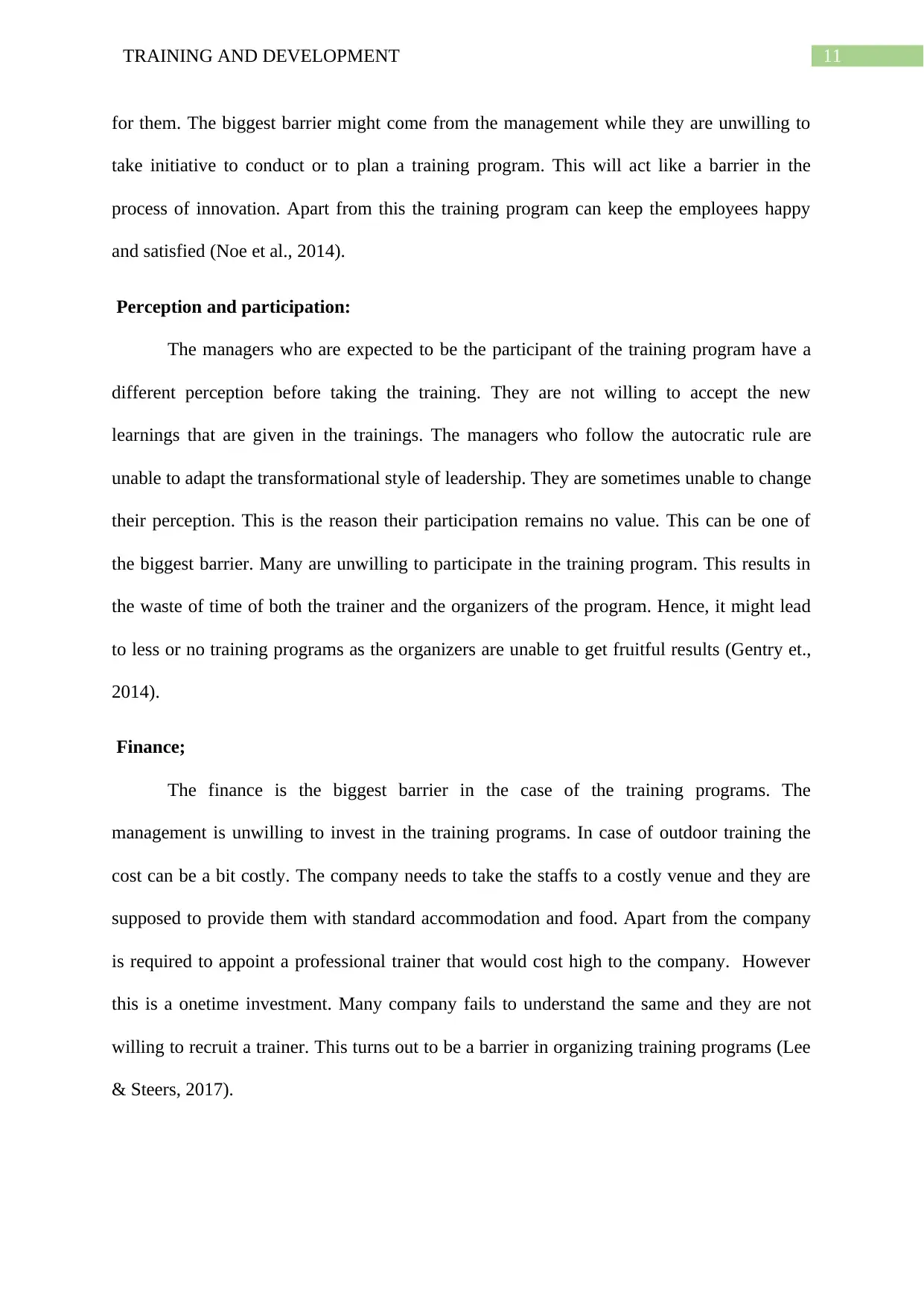
11TRAINING AND DEVELOPMENT
for them. The biggest barrier might come from the management while they are unwilling to
take initiative to conduct or to plan a training program. This will act like a barrier in the
process of innovation. Apart from this the training program can keep the employees happy
and satisfied (Noe et al., 2014).
Perception and participation:
The managers who are expected to be the participant of the training program have a
different perception before taking the training. They are not willing to accept the new
learnings that are given in the trainings. The managers who follow the autocratic rule are
unable to adapt the transformational style of leadership. They are sometimes unable to change
their perception. This is the reason their participation remains no value. This can be one of
the biggest barrier. Many are unwilling to participate in the training program. This results in
the waste of time of both the trainer and the organizers of the program. Hence, it might lead
to less or no training programs as the organizers are unable to get fruitful results (Gentry et.,
2014).
Finance;
The finance is the biggest barrier in the case of the training programs. The
management is unwilling to invest in the training programs. In case of outdoor training the
cost can be a bit costly. The company needs to take the staffs to a costly venue and they are
supposed to provide them with standard accommodation and food. Apart from the company
is required to appoint a professional trainer that would cost high to the company. However
this is a onetime investment. Many company fails to understand the same and they are not
willing to recruit a trainer. This turns out to be a barrier in organizing training programs (Lee
& Steers, 2017).
for them. The biggest barrier might come from the management while they are unwilling to
take initiative to conduct or to plan a training program. This will act like a barrier in the
process of innovation. Apart from this the training program can keep the employees happy
and satisfied (Noe et al., 2014).
Perception and participation:
The managers who are expected to be the participant of the training program have a
different perception before taking the training. They are not willing to accept the new
learnings that are given in the trainings. The managers who follow the autocratic rule are
unable to adapt the transformational style of leadership. They are sometimes unable to change
their perception. This is the reason their participation remains no value. This can be one of
the biggest barrier. Many are unwilling to participate in the training program. This results in
the waste of time of both the trainer and the organizers of the program. Hence, it might lead
to less or no training programs as the organizers are unable to get fruitful results (Gentry et.,
2014).
Finance;
The finance is the biggest barrier in the case of the training programs. The
management is unwilling to invest in the training programs. In case of outdoor training the
cost can be a bit costly. The company needs to take the staffs to a costly venue and they are
supposed to provide them with standard accommodation and food. Apart from the company
is required to appoint a professional trainer that would cost high to the company. However
this is a onetime investment. Many company fails to understand the same and they are not
willing to recruit a trainer. This turns out to be a barrier in organizing training programs (Lee
& Steers, 2017).
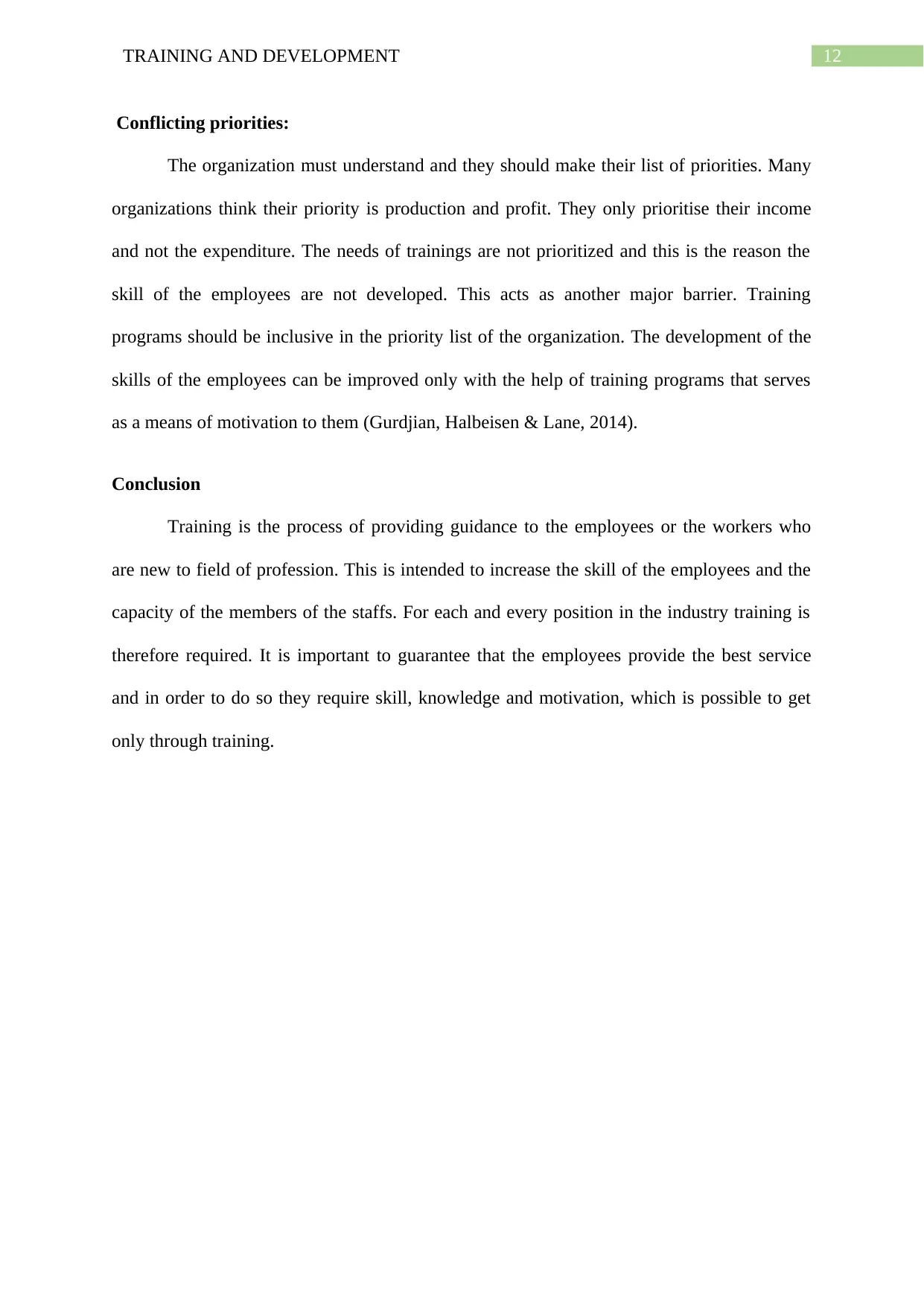
12TRAINING AND DEVELOPMENT
Conflicting priorities:
The organization must understand and they should make their list of priorities. Many
organizations think their priority is production and profit. They only prioritise their income
and not the expenditure. The needs of trainings are not prioritized and this is the reason the
skill of the employees are not developed. This acts as another major barrier. Training
programs should be inclusive in the priority list of the organization. The development of the
skills of the employees can be improved only with the help of training programs that serves
as a means of motivation to them (Gurdjian, Halbeisen & Lane, 2014).
Conclusion
Training is the process of providing guidance to the employees or the workers who
are new to field of profession. This is intended to increase the skill of the employees and the
capacity of the members of the staffs. For each and every position in the industry training is
therefore required. It is important to guarantee that the employees provide the best service
and in order to do so they require skill, knowledge and motivation, which is possible to get
only through training.
Conflicting priorities:
The organization must understand and they should make their list of priorities. Many
organizations think their priority is production and profit. They only prioritise their income
and not the expenditure. The needs of trainings are not prioritized and this is the reason the
skill of the employees are not developed. This acts as another major barrier. Training
programs should be inclusive in the priority list of the organization. The development of the
skills of the employees can be improved only with the help of training programs that serves
as a means of motivation to them (Gurdjian, Halbeisen & Lane, 2014).
Conclusion
Training is the process of providing guidance to the employees or the workers who
are new to field of profession. This is intended to increase the skill of the employees and the
capacity of the members of the staffs. For each and every position in the industry training is
therefore required. It is important to guarantee that the employees provide the best service
and in order to do so they require skill, knowledge and motivation, which is possible to get
only through training.
Paraphrase This Document
Need a fresh take? Get an instant paraphrase of this document with our AI Paraphraser
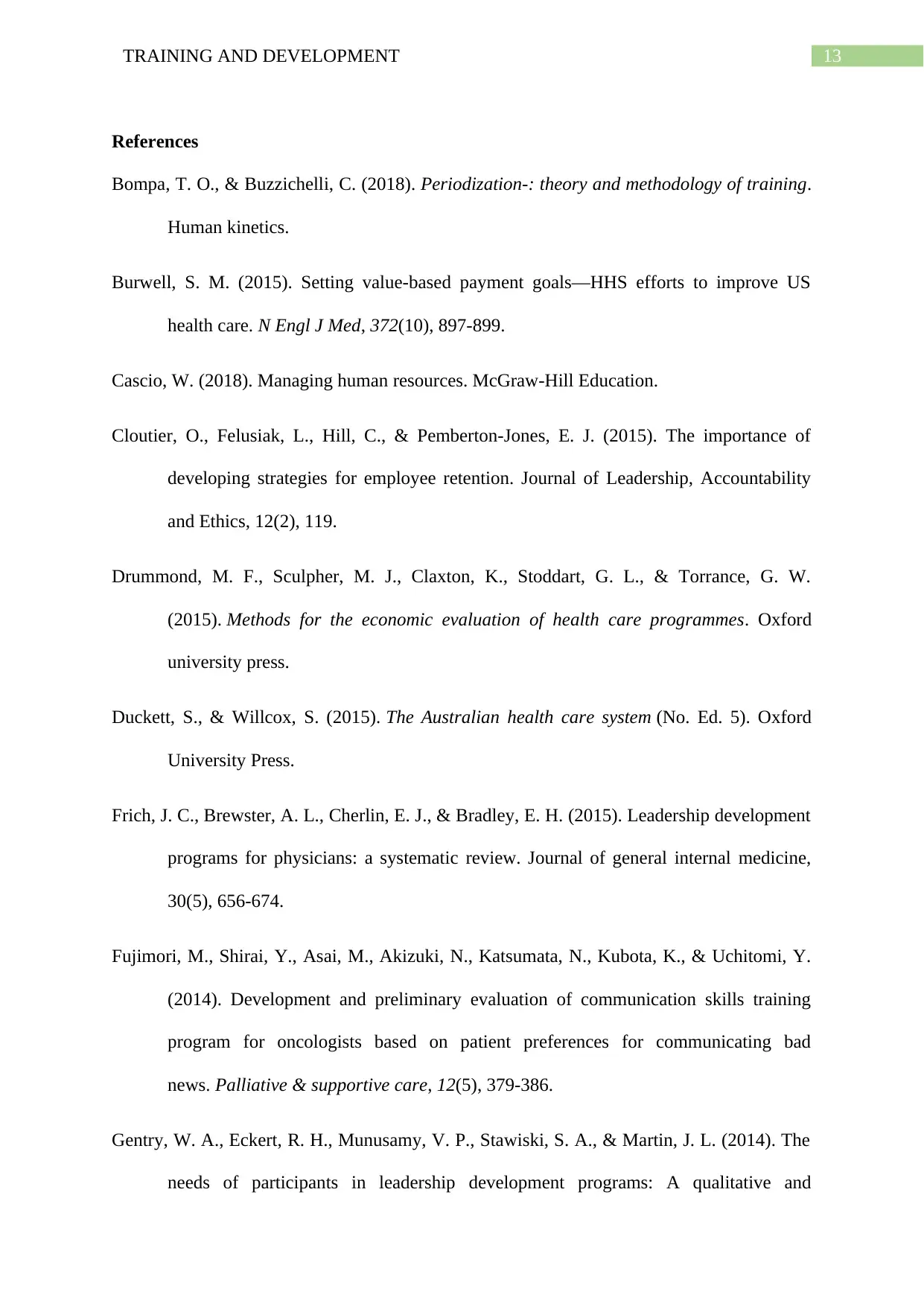
13TRAINING AND DEVELOPMENT
References
Bompa, T. O., & Buzzichelli, C. (2018). Periodization-: theory and methodology of training.
Human kinetics.
Burwell, S. M. (2015). Setting value-based payment goals—HHS efforts to improve US
health care. N Engl J Med, 372(10), 897-899.
Cascio, W. (2018). Managing human resources. McGraw-Hill Education.
Cloutier, O., Felusiak, L., Hill, C., & Pemberton-Jones, E. J. (2015). The importance of
developing strategies for employee retention. Journal of Leadership, Accountability
and Ethics, 12(2), 119.
Drummond, M. F., Sculpher, M. J., Claxton, K., Stoddart, G. L., & Torrance, G. W.
(2015). Methods for the economic evaluation of health care programmes. Oxford
university press.
Duckett, S., & Willcox, S. (2015). The Australian health care system (No. Ed. 5). Oxford
University Press.
Frich, J. C., Brewster, A. L., Cherlin, E. J., & Bradley, E. H. (2015). Leadership development
programs for physicians: a systematic review. Journal of general internal medicine,
30(5), 656-674.
Fujimori, M., Shirai, Y., Asai, M., Akizuki, N., Katsumata, N., Kubota, K., & Uchitomi, Y.
(2014). Development and preliminary evaluation of communication skills training
program for oncologists based on patient preferences for communicating bad
news. Palliative & supportive care, 12(5), 379-386.
Gentry, W. A., Eckert, R. H., Munusamy, V. P., Stawiski, S. A., & Martin, J. L. (2014). The
needs of participants in leadership development programs: A qualitative and
References
Bompa, T. O., & Buzzichelli, C. (2018). Periodization-: theory and methodology of training.
Human kinetics.
Burwell, S. M. (2015). Setting value-based payment goals—HHS efforts to improve US
health care. N Engl J Med, 372(10), 897-899.
Cascio, W. (2018). Managing human resources. McGraw-Hill Education.
Cloutier, O., Felusiak, L., Hill, C., & Pemberton-Jones, E. J. (2015). The importance of
developing strategies for employee retention. Journal of Leadership, Accountability
and Ethics, 12(2), 119.
Drummond, M. F., Sculpher, M. J., Claxton, K., Stoddart, G. L., & Torrance, G. W.
(2015). Methods for the economic evaluation of health care programmes. Oxford
university press.
Duckett, S., & Willcox, S. (2015). The Australian health care system (No. Ed. 5). Oxford
University Press.
Frich, J. C., Brewster, A. L., Cherlin, E. J., & Bradley, E. H. (2015). Leadership development
programs for physicians: a systematic review. Journal of general internal medicine,
30(5), 656-674.
Fujimori, M., Shirai, Y., Asai, M., Akizuki, N., Katsumata, N., Kubota, K., & Uchitomi, Y.
(2014). Development and preliminary evaluation of communication skills training
program for oncologists based on patient preferences for communicating bad
news. Palliative & supportive care, 12(5), 379-386.
Gentry, W. A., Eckert, R. H., Munusamy, V. P., Stawiski, S. A., & Martin, J. L. (2014). The
needs of participants in leadership development programs: A qualitative and

14TRAINING AND DEVELOPMENT
quantitative cross-country investigation. Journal of Leadership & Organizational
Studies, 21(1), 83-101.
Gurdjian, P., Halbeisen, T., & Lane, K. (2014). Why leadership-development programs fail.
McKinsey Quarterly, 1(1), 121-126.
Henoch, I., Strang, S., Browall, M., Danielson, E., & Melin-Johansson, C. (2015).
Development of an existential support training program for healthcare
professionals. Palliative & supportive care, 13(6), 1701-1709.
Hope, A. A., Hsieh, S. J., Howes, J. M., Keene, A. B., Fausto, J. A., Pinto, P. A., & Gong, M.
N. (2015). Let’s talk critical. Development and evaluation of a communication skills
training program for critical care fellows. Annals of the American Thoracic
Society, 12(4), 505-511.
Johnson, M. O., & Gandhi, M. (2015). A mentor training program improves mentoring
competency for researchers working with early-career investigators from
underrepresented backgrounds. Advances in Health Sciences Education, 20(3), 683-
689.
Kumar, V., & Pansari, A. (2015). Measuring the benefits of employee engagement. MIT
Sloan Management Review, 56(4), 67.
Lee, T. W., & Steers, R. M. (2017). Facilitating effective performance appraisals: The role of
employee commitment and organizational climate. In Performance measurement and
theory (pp. 75-93). Routledge.
McCullough, M., Campbell, A., Siu, A., Durnwald, L., Kumar, S., Magee, W. P., &
Swanson, J. (2018). Competency-based education in low resource settings:
quantitative cross-country investigation. Journal of Leadership & Organizational
Studies, 21(1), 83-101.
Gurdjian, P., Halbeisen, T., & Lane, K. (2014). Why leadership-development programs fail.
McKinsey Quarterly, 1(1), 121-126.
Henoch, I., Strang, S., Browall, M., Danielson, E., & Melin-Johansson, C. (2015).
Development of an existential support training program for healthcare
professionals. Palliative & supportive care, 13(6), 1701-1709.
Hope, A. A., Hsieh, S. J., Howes, J. M., Keene, A. B., Fausto, J. A., Pinto, P. A., & Gong, M.
N. (2015). Let’s talk critical. Development and evaluation of a communication skills
training program for critical care fellows. Annals of the American Thoracic
Society, 12(4), 505-511.
Johnson, M. O., & Gandhi, M. (2015). A mentor training program improves mentoring
competency for researchers working with early-career investigators from
underrepresented backgrounds. Advances in Health Sciences Education, 20(3), 683-
689.
Kumar, V., & Pansari, A. (2015). Measuring the benefits of employee engagement. MIT
Sloan Management Review, 56(4), 67.
Lee, T. W., & Steers, R. M. (2017). Facilitating effective performance appraisals: The role of
employee commitment and organizational climate. In Performance measurement and
theory (pp. 75-93). Routledge.
McCullough, M., Campbell, A., Siu, A., Durnwald, L., Kumar, S., Magee, W. P., &
Swanson, J. (2018). Competency-based education in low resource settings:
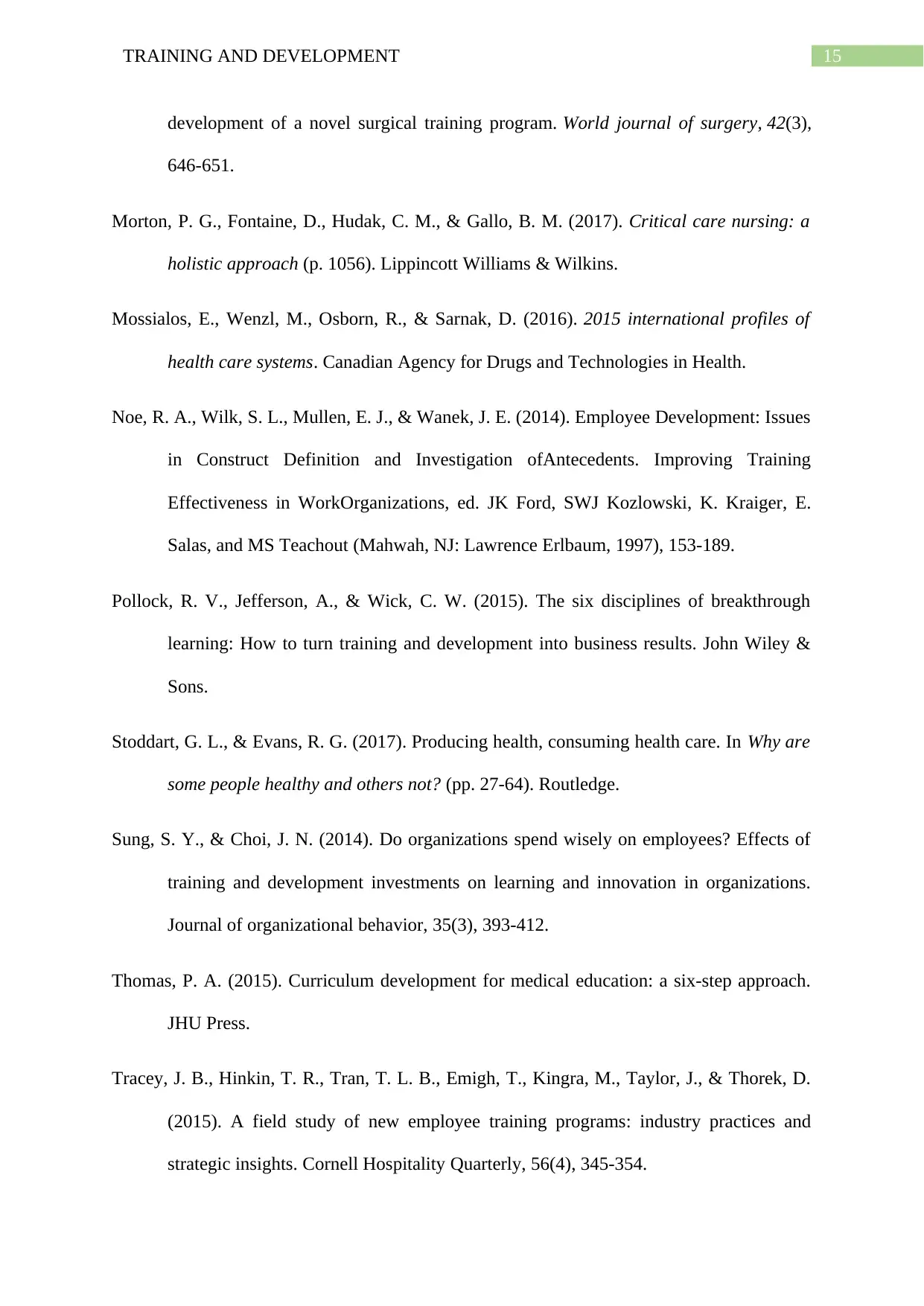
15TRAINING AND DEVELOPMENT
development of a novel surgical training program. World journal of surgery, 42(3),
646-651.
Morton, P. G., Fontaine, D., Hudak, C. M., & Gallo, B. M. (2017). Critical care nursing: a
holistic approach (p. 1056). Lippincott Williams & Wilkins.
Mossialos, E., Wenzl, M., Osborn, R., & Sarnak, D. (2016). 2015 international profiles of
health care systems. Canadian Agency for Drugs and Technologies in Health.
Noe, R. A., Wilk, S. L., Mullen, E. J., & Wanek, J. E. (2014). Employee Development: Issues
in Construct Definition and Investigation ofAntecedents. Improving Training
Effectiveness in WorkOrganizations, ed. JK Ford, SWJ Kozlowski, K. Kraiger, E.
Salas, and MS Teachout (Mahwah, NJ: Lawrence Erlbaum, 1997), 153-189.
Pollock, R. V., Jefferson, A., & Wick, C. W. (2015). The six disciplines of breakthrough
learning: How to turn training and development into business results. John Wiley &
Sons.
Stoddart, G. L., & Evans, R. G. (2017). Producing health, consuming health care. In Why are
some people healthy and others not? (pp. 27-64). Routledge.
Sung, S. Y., & Choi, J. N. (2014). Do organizations spend wisely on employees? Effects of
training and development investments on learning and innovation in organizations.
Journal of organizational behavior, 35(3), 393-412.
Thomas, P. A. (2015). Curriculum development for medical education: a six-step approach.
JHU Press.
Tracey, J. B., Hinkin, T. R., Tran, T. L. B., Emigh, T., Kingra, M., Taylor, J., & Thorek, D.
(2015). A field study of new employee training programs: industry practices and
strategic insights. Cornell Hospitality Quarterly, 56(4), 345-354.
development of a novel surgical training program. World journal of surgery, 42(3),
646-651.
Morton, P. G., Fontaine, D., Hudak, C. M., & Gallo, B. M. (2017). Critical care nursing: a
holistic approach (p. 1056). Lippincott Williams & Wilkins.
Mossialos, E., Wenzl, M., Osborn, R., & Sarnak, D. (2016). 2015 international profiles of
health care systems. Canadian Agency for Drugs and Technologies in Health.
Noe, R. A., Wilk, S. L., Mullen, E. J., & Wanek, J. E. (2014). Employee Development: Issues
in Construct Definition and Investigation ofAntecedents. Improving Training
Effectiveness in WorkOrganizations, ed. JK Ford, SWJ Kozlowski, K. Kraiger, E.
Salas, and MS Teachout (Mahwah, NJ: Lawrence Erlbaum, 1997), 153-189.
Pollock, R. V., Jefferson, A., & Wick, C. W. (2015). The six disciplines of breakthrough
learning: How to turn training and development into business results. John Wiley &
Sons.
Stoddart, G. L., & Evans, R. G. (2017). Producing health, consuming health care. In Why are
some people healthy and others not? (pp. 27-64). Routledge.
Sung, S. Y., & Choi, J. N. (2014). Do organizations spend wisely on employees? Effects of
training and development investments on learning and innovation in organizations.
Journal of organizational behavior, 35(3), 393-412.
Thomas, P. A. (2015). Curriculum development for medical education: a six-step approach.
JHU Press.
Tracey, J. B., Hinkin, T. R., Tran, T. L. B., Emigh, T., Kingra, M., Taylor, J., & Thorek, D.
(2015). A field study of new employee training programs: industry practices and
strategic insights. Cornell Hospitality Quarterly, 56(4), 345-354.
Secure Best Marks with AI Grader
Need help grading? Try our AI Grader for instant feedback on your assignments.

16TRAINING AND DEVELOPMENT
1 out of 17
Related Documents
Your All-in-One AI-Powered Toolkit for Academic Success.
+13062052269
info@desklib.com
Available 24*7 on WhatsApp / Email
![[object Object]](/_next/static/media/star-bottom.7253800d.svg)
Unlock your academic potential
© 2024 | Zucol Services PVT LTD | All rights reserved.





